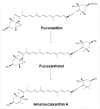Anticancer Effects of Fucoxanthin through Cell Cycle Arrest, Apoptosis Induction, Angiogenesis Inhibition, and Autophagy Modulation
- PMID: 36555740
- PMCID: PMC9785196
- DOI: 10.3390/ijms232416091
Anticancer Effects of Fucoxanthin through Cell Cycle Arrest, Apoptosis Induction, Angiogenesis Inhibition, and Autophagy Modulation
Abstract
Cancer accounts for one in seven deaths worldwide and is the second leading cause of death in the United States, after heart disease. One of the standard cancer treatments is chemotherapy which sometimes can lead to chemoresistance and treatment failure. Therefore, there is a great need for novel therapeutic approaches to treat these patients. Novel natural products have exhibited anticancer effects that may be beneficial in treating many kinds of cancer, having fewer side effects, low toxicity, and affordability. Numerous marine natural compounds have been found to inhibit molecular events and signaling pathways associated with various stages of cancer development. Fucoxanthin is a well-known marine carotenoid of the xanthophyll family with bioactive compounds. It is profusely found in brown seaweeds, providing more than 10% of the total creation of natural carotenoids. Fucoxanthin is found in edible brown seaweed macroalgae such as Undaria pinnatifida, Laminaria japonica, and Eisenia bicyclis. Many of fucoxanthin's pharmacological properties include antioxidant, anti-tumor, anti-inflammatory, antiobesity, anticancer, and antihypertensive effects. Fucoxanthin inhibits many cancer cell lines' proliferation, angiogenesis, migration, invasion, and metastasis. In addition, it modulates miRNA and induces cell cycle growth arrest, apoptosis, and autophagy. Moreover, the literature shows fucoxanthin's ability to inhibit cytokines and growth factors such as TNF-α and VEGF, which stimulates the activation of downstream signaling pathways such as PI3K/Akt autophagy, and pathways of apoptosis. This review highlights the different critical mechanisms by which fucoxanthin inhibits diverse cancer types, such as breast, prostate, gastric, lung, and bladder development and progression. Moreover, this article reviews the existing literature and provides critical supportive evidence for fucoxanthin's possible therapeutic use in cancer.
Keywords: apoptosis; autophagy; cancer; carotenoids; fucoxanthin.
Conflict of interest statement
The authors declare no conflict of interest.
Figures








Similar articles
-
The Anticancer Effects of Marine Carotenoid Fucoxanthin through Phosphatidylinositol 3-Kinase (PI3K)-AKT Signaling on Triple-Negative Breast Cancer Cells.Molecules. 2023 Dec 21;29(1):61. doi: 10.3390/molecules29010061. Molecules. 2023. PMID: 38202644 Free PMC article.
-
Fucoxanthin, a Marine-Derived Carotenoid from Brown Seaweeds and Microalgae: A Promising Bioactive Compound for Cancer Therapy.Int J Mol Sci. 2020 Dec 4;21(23):9273. doi: 10.3390/ijms21239273. Int J Mol Sci. 2020. PMID: 33291743 Free PMC article. Review.
-
Cancer preventive efficacy of marine carotenoid fucoxanthin: cell cycle arrest and apoptosis.Nutrients. 2013 Dec 6;5(12):4978-89. doi: 10.3390/nu5124978. Nutrients. 2013. PMID: 24322524 Free PMC article. Review.
-
A Review of the Effects of Fucoxanthin on NAFLD.Nutrients. 2023 Apr 19;15(8):1954. doi: 10.3390/nu15081954. Nutrients. 2023. PMID: 37111187 Free PMC article. Review.
-
Anticancer Effects of Fucoxanthin through Cell Cycle Arrest, Apoptosis Induction, and Angiogenesis Inhibition in Triple-Negative Breast Cancer Cells.Molecules. 2023 Sep 9;28(18):6536. doi: 10.3390/molecules28186536. Molecules. 2023. PMID: 37764312 Free PMC article.
Cited by
-
Unlocking the Green Gold: Exploring the Cancer Treatment and the Other Therapeutic Potential of Fucoxanthin Derivatives from Microalgae.Pharmaceuticals (Basel). 2024 Jul 18;17(7):960. doi: 10.3390/ph17070960. Pharmaceuticals (Basel). 2024. PMID: 39065808 Free PMC article. Review.
-
Anti-inflammatory activity of peiminine in acetic acid-induced ulcerative colitis model.Inflammopharmacology. 2024 Feb;32(1):657-665. doi: 10.1007/s10787-023-01360-4. Epub 2023 Oct 19. Inflammopharmacology. 2024. PMID: 37855980
-
The Risk of Breast Cancer between Western and Mediterranean Dietary Patterns.Nutrients. 2023 Apr 25;15(9):2057. doi: 10.3390/nu15092057. Nutrients. 2023. PMID: 37432206 Free PMC article. Review.
-
Anticancer Activity of Plant Tocotrienols, Fucoxanthin, Fucoidan, and Polyphenols in Dietary Supplements.Nutrients. 2024 Dec 11;16(24):4274. doi: 10.3390/nu16244274. Nutrients. 2024. PMID: 39770896 Free PMC article.
-
Carotenoids Modulate FoxO-Induced Cell Cycle Awrrest in Human Cancer Cell Lines: A Scoping Review.Food Sci Nutr. 2025 Mar 28;13(4):e70100. doi: 10.1002/fsn3.70100. eCollection 2025 Apr. Food Sci Nutr. 2025. PMID: 40161411 Free PMC article.
References
-
- Henley S.J., Thomas C.C., Lewis D.R., Ward E.M., Islami F., Wu M., Weir H.K., Scott S., Sherman R.L., Ma J., et al. Annual report to the nation on the status of cancer, part II: Progress toward Healthy People 2020 objectives for 4 common cancers. Cancer. 2020;126:2250–2266. doi: 10.1002/cncr.32801. - DOI - PMC - PubMed
-
- Cancer Stat Facts: Common Cancer Sites. [(accessed on 20 May 2022)];2022 Available online: https://seer.cancer.gov/statfacts/html/common.html.
Publication types
MeSH terms
Substances
Grants and funding
LinkOut - more resources
Full Text Sources
Medical

